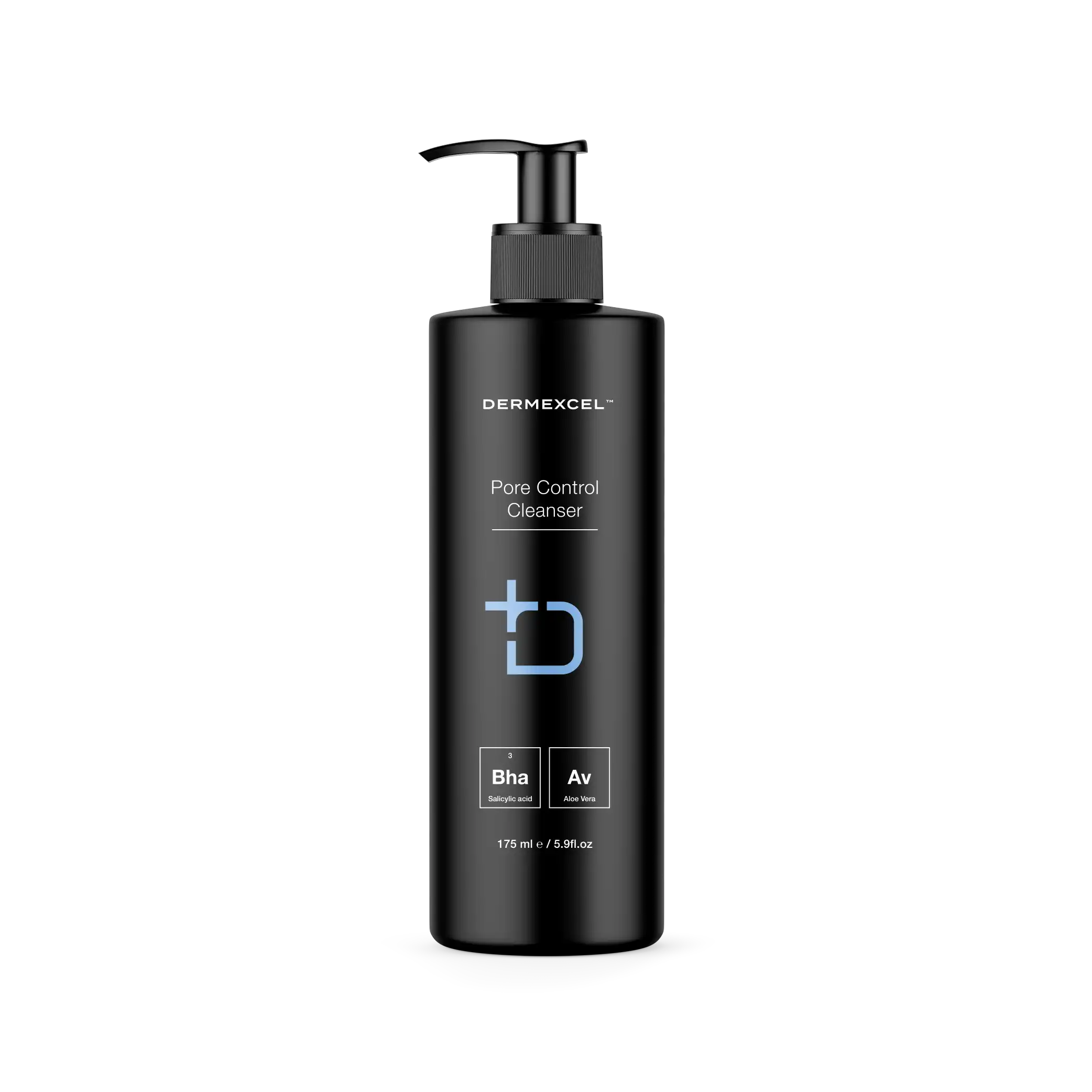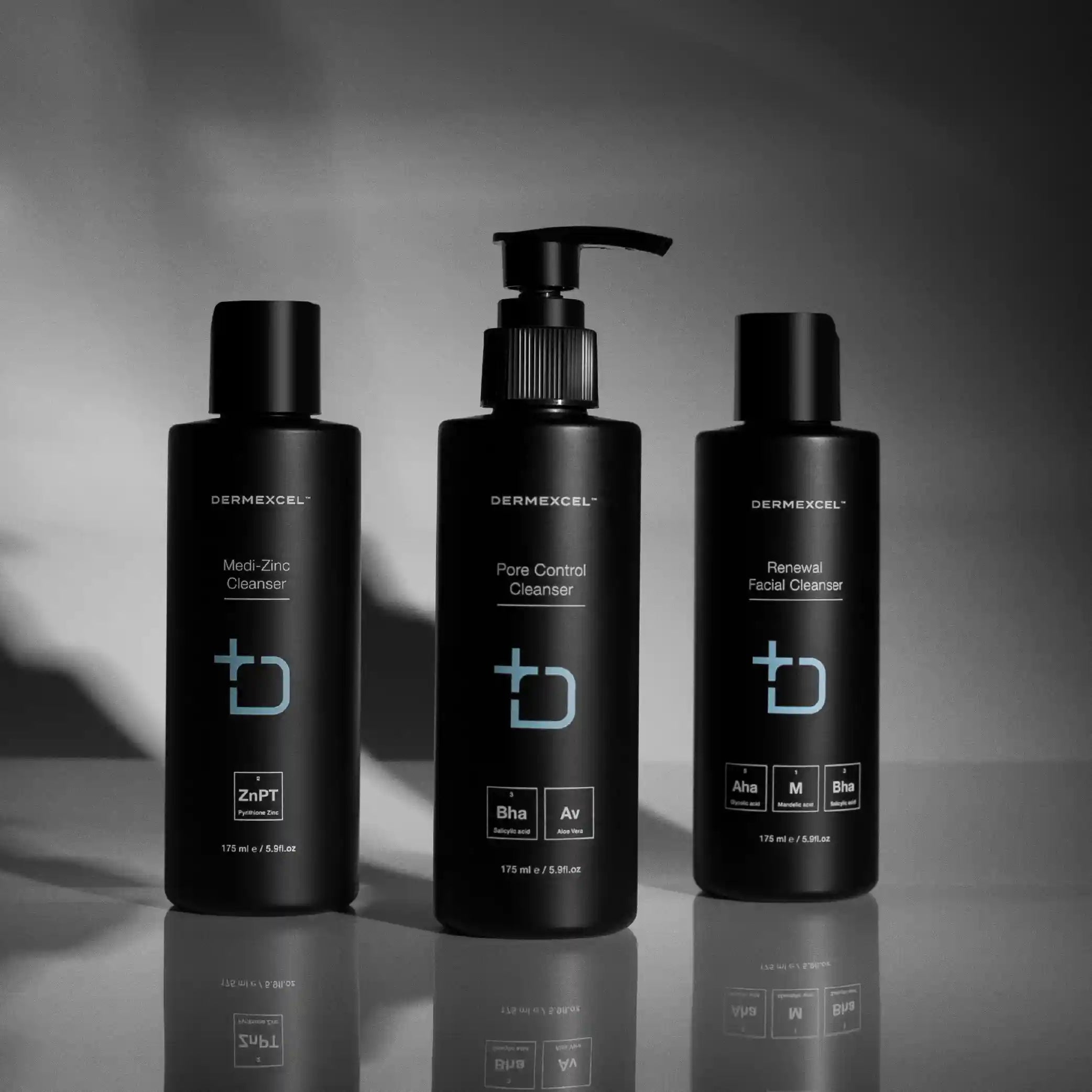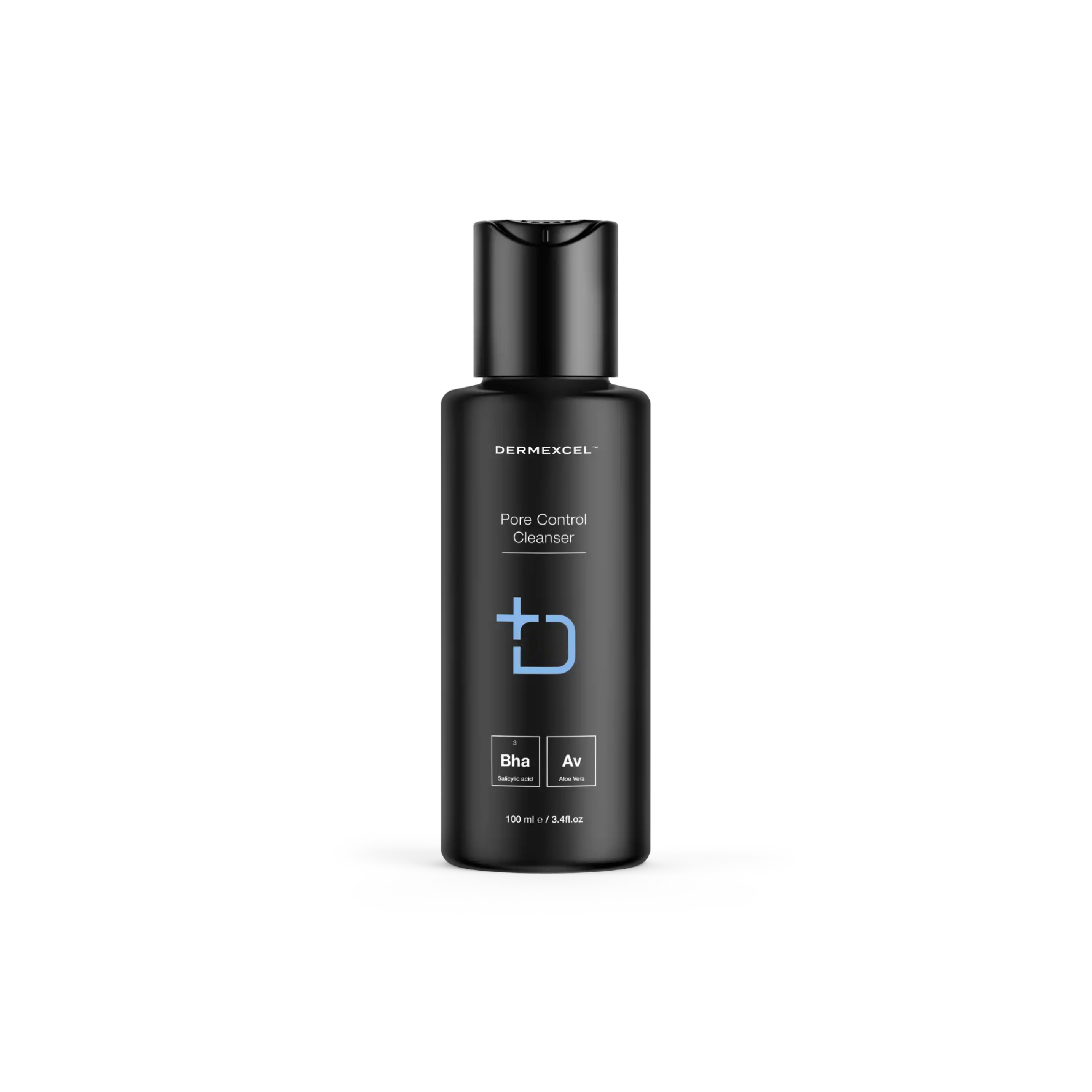






Please login to view the price
login
Unclog Pores

Minimize Pores

Anti-Acne

anti-redness

↓ inflammation
This scientifically formulated skincare solution regulates sebum production, thereby mitigating pore congestion. It employs a 3% concentration of Salicylic acid, a renowned anti-inflammatory agent, which diligently alleviates skin irritation and redness. This ingredient is also known for its potent anti-bacterial properties, effectively cleansing the skin of stubborn impurities.
A distinguishing feature of this cleanser is its inclusion of medical-grade Aloe Vera, a natural ingredient revered for its skin-nourishing capabilities. Aloe Vera imparts soothing and hydrating effects, particularly beneficial for skin dehydration due to other acne treatments.
Pore Control Cleanser is a balanced blend of scientifically proven ingredients that synergistically maintain skin health. It normalizes oil production, dislodges sebum plugs, reduces inflammation, and nourishes the skin, making it a comprehensive solution for maintaining a clear and healthy complexion.
Salicylic acid
Salicylic acid, a renowned beta hydroxy acid (BHA), is a cornerstone in dermatology and skincare due to its exceptional keratolytic and comedolytic properties. Its unique ability to penetrate oil-laden hair follicle pores makes it particularly effective in treating acne-prone and oily skin types.
Salicylic acid dissolves skin debris (sebum and dead skin cells) that clogs pores and causes acne. It's a mild antibacterial and powerful anti-inflammatory agent that helps reduce the redness and swelling associated with breakouts.
What sets salicylic acid apart in dermatological treatments is its ability to exfoliate the skin, not just on the surface but within the pores themselves. This is due to its oil-soluble nature, which allows it to penetrate deep into the pores and dissolve the keratin plugs that lead to blackheads and whiteheads.
Furthermore, salicylic acid also has the capacity to adjust the pH of the skin, creating an environment less favorable for the growth of acne-causing bacteria. Salicylic acid's efficacy in treating various skin conditions, particularly acne, has been extensively documented in the scientific literature. Studies have consistently shown its ability to reduce acne lesions in terms of count and severity. Additionally, salicylic acid is highly recommended for its effectiveness in treating other skin conditions, such as psoriasis and dandruff, due to its ability to soften and remove scales and flakes from the skin.
Physiological Effects
- Keratolytic Action: Salicylic acid is known for its ability to exfoliate the skin by dissolving the intercellular 'glue' that holds skin cells together, helping to remove dead skin cells and unclog pores.
- Comedolytic Effect: It is particularly effective in reducing comedones (blackheads and whiteheads) by unclogging pores and preventing the formation of new comedones.
- Anti-inflammatory Properties: Salicylic acid reduces inflammation, which is beneficial in treating acne and other inflammatory skin conditions.
- Sebum Regulation: It helps to regulate oil production, making it a valuable ingredient for managing oily and acne-prone skin.
- Penetration Enhancement: Due to its lipophilic nature, it can penetrate sebum-filled follicles, effectively treating acne located deep within the pores.
Managing Dermatological Conditions
- Acne Vulgaris: Salicylic acid is a cornerstone in acne treatment, effectively preventing and treating existing acne lesions.
- Psoriasis: Its keratolytic properties make it helpful in softening and removing scales associated with psoriasis.
- Warts: Salicylic acid is commonly used to treat warts because it can exfoliate and remove thick skin.
- Seborrheic Dermatitis: It helps manage seborrheic dermatitis by reducing scaling and redness.
- Keratosis Pilaris: Salicylic acid can aid in smoothing the rough bumps associated with peratosis Pilaris.
References
- Zaenglein, A. L., Pathy, A. L., Schlosser, B. J., Alikhan, A., Baldwin, H. E., Berson, D. S., & Thiboutot, D. M. (2016). Guidelines of care for the management of acne vulgaris. Journal of the American Academy of Dermatology, 74(5), 945-973.e33.
- Kornhauser, A., Coelho, S. G., & Hearing, V. J. (2010). Applications of hydroxy acids: classification, mechanisms, and photoactivity. Clinical, cosmetic and investigational dermatology, 3, 135.
- Zander, E., & Weisman, S. (1992). Treatment of acne vulgaris with salicylic acid pads. Clinical Therapeutics.
- Gupta, A. K., & Nicol, K. (2004). The use of sulfur in dermatology. Journal of Drugs in Dermatology.
Aloe Vera
Aloe vera is well-regarded for its medicinal applications and has been a staple in skincare and health for centuries. It’s rich in vitamins, enzymes, minerals, and amino acids, contributing to its many skin benefits.
Aloe vera contains polysaccharides, which are crucial in its moisturizing and anti-inflammatory properties. These polysaccharides help bind moisture to the skin, making aloe vera an excellent hydrating agent for dry and damaged skin.
One of the key benefits of aloe vera is its soothing and healing properties, particularly beneficial for burns, abrasions, and skin irritations. It has been shown to accelerate the healing of minor burns and reduce skin inflammation. Various studies have supported its effectiveness in treating first- and second-degree burns, highlighting its role in enhancing collagen synthesis and skin regeneration.
Aloe vera's anti-inflammatory properties are attributed to compounds like glycoproteins and polysaccharides. These compounds help reduce pain and swelling associated with skin irritations and wounds. Aloe vera also contains aloin and emodin, which provide analgesic, antibacterial, and antiviral properties, further extending its therapeutic potential.
Aloe Vera has numerous physiological effects on the skin due to its rich composition of vitamins, enzymes, minerals, and amino acids. The presence of antioxidants such as vitamins C and E, along with beta-carotene, contributes to its anti-aging benefits, helping to improve skin firmness and keep the skin hydrated.
Physiological Effects
- Moisturizing and Hydrating: Aloe Vera enhances skin hydration, making it effective for dry and dehydrated skin. Its mucopolysaccharides help to bind moisture into the skin.
- Wound Healing: It accelerates wound healing by enhancing collagen synthesis and cross-linking. This effect is particularly useful in healing burns, abrasions, and cuts.
- Anti-inflammatory Properties: Aloe Vera contains compounds like aloin and anthraquinones that have anti-inflammatory properties, making it beneficial in reducing skin inflammation.
- Antimicrobial Activity: It possesses antimicrobial properties, which help in preventing infections in wounds and burns.
- Antioxidant Properties: The presence of vitamins C and E and beta-carotene provides it with antioxidant properties, which can help protect the skin from free radical damage.
- Soothing Effect: Aloe Vera is known for its soothing effects on the skin, particularly in conditions like sunburn.
Managing Dermatological Conditions
- Burns and Wound Care: Aloe Vera's wound-healing and soothing properties make it effective in treating burns, including sunburns and minor skin abrasions.
- Acne Treatment: Due to its antimicrobial and anti-inflammatory properties, it can help treat acne.
- Eczema and Psoriasis: Its moisturizing, anti-inflammatory, and soothing properties are beneficial in managing symptoms of eczema and psoriasis.
- Aging Skin: Aloe Vera's antioxidant properties and ability to improve collagen production can help reduce the signs of aging.
- Skin Hydration: It's a common ingredient in moisturizers and other skin care products for its hydrating properties.
References
- Surjushe, A., Vasani, R., & Saple, D. G. (2008). Aloe vera: A short review. Indian Journal of Dermatology.
- Maenthaisong, R., Chaiyakunapruk, N., Niruntraporn, S., & Kongkaew, C. (2007). The efficacy of aloe vera used for burn wound healing: A systematic review. Burns.
- Rajeswari, R., Umadevi, M., Rahale, C. S., Pushpa, R., Selvavenkadesh, S., Kumar, K. S., & Bhowmik, D. (2012). Aloe vera: The miracle plant its medicinal and traditional uses in India. Journal of Pharmacognosy and Phytochemistry.




SHIPPING
- Shipping Guarantee: Guiding you to healthy skin isn’t only about our products; it's also about getting them to you as swiftly as the science behind them. That's why Dermal Health offers a shipping guarantee you can rely on.
- Where We Ship From: Orders are dispatched from our facilities in Pretoria.
- Who We Ship With: We trust only well-known, popular, and dependable courier services with your packages.
- When You'll Get It: Expect confident skin soon! Shipping addresses in Pretoria and Johannesburg will enjoy delivery from same-day to 2 business days. Shipping addresses further from Pretoria may expect delivery within 1-4 business days, depending on the service you select during checkout. Your estimated delivery date will reflect during checkout so that you can mark your calendar.
- Tracking Your Order: Eager to start your DermExcel journey? We don't blame you! You'll receive a tracking number after you place your order so that you can follow your package.
For any shipping inquiries, our customer service team is ready to assist.
RETURNS
180-Day Satisfaction Guarantee
Want to log a return? We’ve got you.
You’re welcome to return any product within 180 days of purchase—even if it’s not defective—as long as it’s sealed, unused, in its original packaging, and still within six months of its labeled expiration date (located on the bottom of the product). We get it: sometimes things change.
For non-defective returns, courier costs will be your responsibility.
If you believe a product is defective, please provide a brief explanation so our team can properly assess and process your claim.
Just complete our quick Return Form and we’ll take it from there.
Healthy Skin Isn’t Complicated. Neither Is Our Return Policy.
Visit our Return Policy page or contact our friendly support team if you need assistance.
SECURE PAYMENT
Dermal Health Science 30-Day Confidence Guarantee: We are passionate about guiding you to healthy skin through medical science. We believe in the quality and effectiveness of our products so much that we offer a 30-Day Confidence Guarantee. If you're unsatisfied with your purchase, simply return it within 30 days for a full refund.
Healthy Skin Is Not Complicated and neither is our return policy. Please visit our detailed return policy or contact our friendly customer service team for more information.
Feel as confident in us as we want you to feel in your skin.
- Excessive Sebum Production: Regulate sebum production. It helps balance and normalize the skin's oil production, preventing excessive oiliness that may lead to inflammatory skin conditions, including acne and rosacea.
- Congested Pores: This treatment dislodges sebum plugs from clogged pores, targets and removes sebum plugs, unclogging pores and preventing the formation of blackheads and whiteheads.
- Skin irritation and redness: Anti-inflammatory action that reduces skin redness and irritation.
- Acne Breakouts: Pore Control cleanser's effective targeting of acne breakouts is due to its sebum regulation, comedolytic action, and anti-inflammatory action.
- Maintenance of Skin Health: Regular usage can help maintain the skin's overall health by controlling oil production and keeping pores clean.
- Dehydrated Skin: Including medical-grade Aloe Vera in the formulation makes this cleanser suitable for individuals with dehydrated skin, as Aloe Vera is known for its hydrating and soothing properties.
- Application time: Use in the morning and evening.
- Frequency: Every day or as per your Dermal Diagnosis regimen instructions.
Sensitive Skin
- Use only in the evening. In the morning, wipe your face with a lukewarm, wet facecloth or microfibre sponge. This will help remove dead skin that the cleanser dissolves and loosens.
- Apply cleanser to a wet face. The water will help neutralize the cleanser and decrease its potency. Be careful when applying the cleanser around your eyes, as the water may cause the cleanser to run into your eyes, which will sting. Rather, avoid the eye area and remove eye makeup (if applicable) with your microfibre sponge, using a small drop of cleanser mixed with water and lathered into the sponge.
- Keep the cleanser in contact with your skin for 1 minute or shorter.
- Remove the cleanser with a clean, lukewarm face cloth or microfibre face sponge. This will also help remove excess makeup and loose, peeling skin.
- Tip: Keep the cleanser on your skin while brushing your teeth, bathing, or getting dressed.
Resistant Skin
- Use morning and evening.
- Apply to dry skin. If you apply your cleanser to dry skin, you can circulate it over your eyes without burning or stinging.
- You may want to dampen your fingers slightly to help with spreading. If you have resistant skin, you should not use too much water while cleaning, as water will alter the pH of the cleanser, rendering it less potent.
- Keep the cleanser on your skin for 3 minutes or longer.
- Remove the cleanser with a clean, lukewarm face cloth or microfibre face sponge. This will also help remove excess makeup and loose, peeling skin.
- Tip: Keep the cleanser on your skin while brushing your teeth, bathing, or getting dressed.
Active ingredients
- Keratolytic Action: Salicylic acid is known for its ability to exfoliate the skin by dissolving the intercellular 'glue' that holds skin cells together, helping to remove dead skin cells and unclog pores.
- Comedolytic Effect: It is particularly effective in reducing comedones (blackheads and whiteheads) by unclogging pores and preventing the formation of new comedones.
- Anti-inflammatory Properties: Salicylic acid reduces inflammation, which is beneficial in treating acne and other inflammatory skin conditions.
- Sebum Regulation: It helps to regulate oil production, making it a valuable ingredient for managing oily and acne-prone skin.
- Penetration Enhancement: Due to its lipophilic nature, it can penetrate sebum-filled follicles, effectively treating acne located deep within the pores.
- Acne Vulgaris: Salicylic acid is a cornerstone in acne treatment, effectively preventing and treating existing acne lesions.
- Psoriasis: Its keratolytic properties make it helpful in softening and removing scales associated with psoriasis.
- Warts: Salicylic acid is commonly used to treat warts because it can exfoliate and remove thick skin.
- Seborrheic Dermatitis: It helps manage seborrheic dermatitis by reducing scaling and redness.
- Keratosis Pilaris: Salicylic acid can aid in smoothing the rough bumps associated with peratosis Pilaris.
- Zaenglein, A. L., Pathy, A. L., Schlosser, B. J., Alikhan, A., Baldwin, H. E., Berson, D. S., & Thiboutot, D. M. (2016). Guidelines of care for the management of acne vulgaris. Journal of the American Academy of Dermatology, 74(5), 945-973.e33.
- Kornhauser, A., Coelho, S. G., & Hearing, V. J. (2010). Applications of hydroxy acids: classification, mechanisms, and photoactivity. Clinical, cosmetic and investigational dermatology, 3, 135.
- Zander, E., & Weisman, S. (1992). Treatment of acne vulgaris with salicylic acid pads. Clinical Therapeutics.
- Gupta, A. K., & Nicol, K. (2004). The use of sulfur in dermatology. Journal of Drugs in Dermatology.
- Moisturizing and Hydrating: Aloe Vera enhances skin hydration, making it effective for dry and dehydrated skin. Its mucopolysaccharides help to bind moisture into the skin.
- Wound Healing: It accelerates wound healing by enhancing collagen synthesis and cross-linking. This effect is particularly useful in healing burns, abrasions, and cuts.
- Anti-inflammatory Properties: Aloe Vera contains compounds like aloin and anthraquinones that have anti-inflammatory properties, making it beneficial in reducing skin inflammation.
- Antimicrobial Activity: It possesses antimicrobial properties, which help in preventing infections in wounds and burns.
- Antioxidant Properties: The presence of vitamins C and E and beta-carotene provides it with antioxidant properties, which can help protect the skin from free radical damage.
- Soothing Effect: Aloe Vera is known for its soothing effects on the skin, particularly in conditions like sunburn.
- Burns and Wound Care: Aloe Vera's wound-healing and soothing properties make it effective in treating burns, including sunburns and minor skin abrasions.
- Acne Treatment: Due to its antimicrobial and anti-inflammatory properties, it can help treat acne.
- Eczema and Psoriasis: Its moisturizing, anti-inflammatory, and soothing properties are beneficial in managing symptoms of eczema and psoriasis.
- Aging Skin: Aloe Vera's antioxidant properties and ability to improve collagen production can help reduce the signs of aging.
- Skin Hydration: It's a common ingredient in moisturizers and other skin care products for its hydrating properties.
- Surjushe, A., Vasani, R., & Saple, D. G. (2008). Aloe vera: A short review. Indian Journal of Dermatology.
- Maenthaisong, R., Chaiyakunapruk, N., Niruntraporn, S., & Kongkaew, C. (2007). The efficacy of aloe vera used for burn wound healing: A systematic review. Burns.
- Rajeswari, R., Umadevi, M., Rahale, C. S., Pushpa, R., Selvavenkadesh, S., Kumar, K. S., & Bhowmik, D. (2012). Aloe vera: The miracle plant its medicinal and traditional uses in India. Journal of Pharmacognosy and Phytochemistry.
Salicylic acid
Salicylic acid, a renowned beta hydroxy acid (BHA), is a cornerstone in dermatology and skincare due to its exceptional keratolytic and comedolytic properties. Its unique ability to penetrate oil-laden hair follicle pores makes it particularly effective in treating acne-prone and oily skin types.
Salicylic acid dissolves skin debris (sebum and dead skin cells) that clogs pores and causes acne. It's a mild antibacterial and powerful anti-inflammatory agent that helps reduce the redness and swelling associated with breakouts.
What sets salicylic acid apart in dermatological treatments is its ability to exfoliate the skin, not just on the surface but within the pores themselves. This is due to its oil-soluble nature, which allows it to penetrate deep into the pores and dissolve the keratin plugs that lead to blackheads and whiteheads.
Furthermore, salicylic acid also has the capacity to adjust the pH of the skin, creating an environment less favorable for the growth of acne-causing bacteria. Salicylic acid's efficacy in treating various skin conditions, particularly acne, has been extensively documented in the scientific literature. Studies have consistently shown its ability to reduce acne lesions in terms of count and severity. Additionally, salicylic acid is highly recommended for its effectiveness in treating other skin conditions, such as psoriasis and dandruff, due to its ability to soften and remove scales and flakes from the skin.
Physiological Effects
Managing Dermatological Conditions
References
Aloe Vera
Aloe vera is well-regarded for its medicinal applications and has been a staple in skincare and health for centuries. It’s rich in vitamins, enzymes, minerals, and amino acids, contributing to its many skin benefits.
Aloe vera contains polysaccharides, which are crucial in its moisturizing and anti-inflammatory properties. These polysaccharides help bind moisture to the skin, making aloe vera an excellent hydrating agent for dry and damaged skin.
One of the key benefits of aloe vera is its soothing and healing properties, particularly beneficial for burns, abrasions, and skin irritations. It has been shown to accelerate the healing of minor burns and reduce skin inflammation. Various studies have supported its effectiveness in treating first- and second-degree burns, highlighting its role in enhancing collagen synthesis and skin regeneration.
Aloe vera's anti-inflammatory properties are attributed to compounds like glycoproteins and polysaccharides. These compounds help reduce pain and swelling associated with skin irritations and wounds. Aloe vera also contains aloin and emodin, which provide analgesic, antibacterial, and antiviral properties, further extending its therapeutic potential.
Aloe Vera has numerous physiological effects on the skin due to its rich composition of vitamins, enzymes, minerals, and amino acids. The presence of antioxidants such as vitamins C and E, along with beta-carotene, contributes to its anti-aging benefits, helping to improve skin firmness and keep the skin hydrated.
Physiological Effects
Managing Dermatological Conditions
References
Full Ingredient list
Aqua, Methylpropanediol, Cocoamidopropyl betaine, Glycol monostearate, Glycerin, Sodium Lauroyl Sarcosinate, Salicylic acid, d-Panthenol, Azelamidopropyl dimethyl amine, Butylene glycol, Polyacrylate Crosspolymer-6, Phenoxyethanol, Ethylhexylglycerin, Aloe barbadensis, Hydroxyethylcellulose, Disodium EDTA, Hamamelia Virginiana
Pore Control Cleanser
product benefits

Remove blackheads
Penetrate deep into the pores to dissolve sebum and dead skin cells, preventing the buildup that leads to blockages.

Targeted Acne Treatment
Promote cellular turnover, reduce pore congestion, eliminate acne-causing bacteria, and down-regulate inflammation, resulting in a smooth and healthy complexion.

Exfoliating
Promote vibrant skin by removing dead skin layers that clog pores, leading to acne and the dull appearance associated with skin aging.

Anti-inflammatory
Alleviates skin irritation and redness by targeting inflammatory pathways and markers, offering significant relief for inflamed skin conditions.

Sebum Regulation
Implement effective sebum regulation strategies to minimize complications and refine the visual condition of oily skin.

Anti-Microbial
Manage microbial activity by inhibiting the growth of pathogenic bacteria, balancing the skin's microbiome, and reducing the risk of infections and inflammation.
Indications for Pore Control Cleanser
Inflammation
Clogged Pores
Enlarged Pores
Sensitive Skin
pore control cleanser
mode of action
Unclog Pores
SALICYLIC ACID
- Salicylic acid is lipophilic, which means it can penetrate oily skin and clogged pores, resulting in deep cleaning.
- Decongests pores by dissolving and extracting dirt, oil, and cellular debris in the pores and follicles.
Anti-Aging
SALICYLIC ACID
- Salicylic acid brightens the complexion. It acts as an exfoliant by softening and dissolving keratin, thus allowing dead skin cells to shed naturally.
- Studies have indicated that Salicylic acid's exfoliating properties reduce the appearance of fine lines and wrinkles. Over time, exfoliation helps to reduce the thickness of the layer of dead skin cells, giving the skin a brighter, more glowing appearance.
______
ALOE VERA
- Antioxidants in Aloe Vera, combined with its support of collagen synthesis, contribute to smoother and firmer skin, helping reduce the appearance of aging signs
Regulate Sebum (oil)
- Salicylic acid works well to balance sebum levels because it is lipid or oil-soluble. So, rather than remaining on the skin's surface, Salicylic acid penetrates deep into sebum-filled pores.
Microbial Control
SALICYLIC ACID
- It inhibits the production of various aspects necessary for bacterial reproduction, such as fibrinogen, fibronectin, and alpha-hemolysis. Therefore, Salicylic acid may neutralize the bacteria C. acnes in blemishes.
______
ALOE VERA
- Aloe Vera possesses natural antimicrobial properties that help protect the skin from bacterial growth, assisting in managing acne and promoting clearer, healthier skin.
- Aloin and emodin components in Aloe Vera target bacteria, which supports the management of acne-prone skin without causing irritation.
Anti-inflammatory & Anti-acne
SALICYLIC ACID
- Salicylic acid reduces sebum secretion.
- Salicylic acid has potent anti-inflammatory effects, inhibiting the arachidonic acid cascade.
- Salicylic acid reduces inflammation by modulating COX2 gene expression to decrease the formation of pro-inflammatory cytokines.
______
ALOE VERA
- Aloe Vera contains compounds like aloin and anthraquinones, which provide anti-inflammatory benefits by reducing redness, swelling, and irritation in the skin.
- Its anti-inflammatory effects help soothe sensitive areas and support a calm skin environment.
Exfoliating
SALICYLIC ACID
- Salicylic acid works well to balance sebum levels because it is lipid or oil-soluble. So, rather than remaining on the skin's surface, Salicylic acid penetrates deep into sebum-filled pores.
- Salicylic acid works by loosening and breaking apart desmosomes (attachments between cells in the outer layers of the skin). This action encourages the exfoliation of dead and damaged skin and unclogging pores.
- Disrupts cellular junctions to exfoliate dead skin cells.
Barrier Support & Soothing
ALOE VERA
- Its polysaccharides form a moisture barrier, preventing water loss and supporting a supple, balanced skin appearance.
- Known for its gentle, soothing effects, Aloe Vera alleviates discomfort and irritation caused by environmental exposure.
- Aloe Vera accelerates wound healing by stimulating collagen synthesis and cross-linking, which promotes skin regeneration in cases of minor skin irritation.
salicylic acid
pore clearing action
Sebum (oil) and dead skin cells accumulate inside the pores, causing blackheads and whiteheads.
Salicylic acid has the unique ability to penetrate the pores and to dissolve and extract the oil and dead skin cell plug.
mode of action
salicylic acid as acne treatment

Keratolytic
Disrupts cellular junctions to exfoliate dead skin, revealing bright, new cells.

Comedolytic
Unclog pores by dissolving and extracting dirt, oil, and cellular debris.

Anti-bacterial
Inhibits bacteria responsible for causing and aggravating acne and rosacea.

anti-inflammatory
Inhibit the inflammation that leads to breakouts, redness, and skin damage.
Testimonials
Renewal Facial Cleanser
I have loved your facial cleanser for a few years now. It really works better than any other product I have used in the past. I have been getting alot of breakouts on my chin these past 6 months. I have tried everything but nothing takes it away
I am genuinely in awe of The Renewal Facial Cleanser. From the very first use, my skin felt cleaner, softer, and more balanced — and with continued use, I can truly see a difference in my skin’s texture and overall glow.
It cleanses thoroughly without stripping my skin or leaving it feeling tight or dry, which is something I’ve always struggled to find in a cleanser. My skin feels refreshed, healthy, and cared for after every wash.
I can confidently say I’ve found the perfect facial cleanser for me and my skin. I won’t be using any other cleanser going forward — this one has earned a permanent place in my skincare routine.
Perfect



